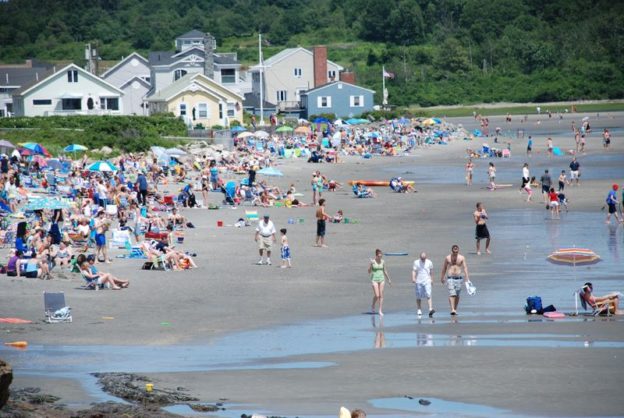When people in the Portland area tell veteran surfer Joe Conway that they’re interested in learning the sport, he says, “Oh yeah? Go to Higgins Beach.”
Located an easy 15 minutes south of Conway’s home in Portland, Higgins Beach stretches for seven tenths of a mile along Saco Bay in Scarborough. Conway loves how “friendly” the beach is, a word he uses to refer to both the constant supply of gentle waves and the exceptional camaraderie among the surfers. Surfers often discourage beginners, but everybody cheers for each other at Higgins. “It’s really refreshing,” he says.
In the peak summer months, surfing is forbidden from 11 a.m. to 5 p.m. when the beach is usually full of families and young people, so surfers have to go out early in the morning or at the end of the day and must park some distance away. From the beginning of June through the end of September, the small neighborhood of 350 simple cottages with weathered clapboard siding and names like “Spindrift” and “Green Bean” fills up with tourists who come in from away, often paying more than $1,500 a week to rent out even the cozier cottages.
In the winter, however, it’s a different story. The parking and time restrictions are gone, the beach’s two inns are closed, and The Higgins Beach Market, the only store in the neighborhood, is shut down. Oceanfront homes go for as little as $1,000 per month during the 8-month off-season, less than a sixth of what they are in the summer. It’s free reign for winter surfers, and they aren’t the only ones.
It’s difficult to get hard numbers on the exact size of the beach’s winter population, but it’s definitely growing. Rod Laughton, the owner of The Breakers Inn, an establishment that has been in his family for generations, grew up on Higgins Beach in the 1960s and remembers the winters being very quiet. “When I was a kid,” he says, “Maybe a quarter of the houses on each street were occupied. Now, almost all the homes are used to some extent in the off-season.”
Scott Townsend, a local real estate agent, says that living at Higgins Beach in the winter seems to work well for many people relocating to southern Maine or going through transitions in their lives as well as young people looking for a temporary and relatively cheap place to live. The area has also become a popular place for the owners of the cottages to retire.
Winter rentals are not usually a top priority for the homeowners. “They’re more a function of having somebody in there to look after the property and pay the heat,” says Townsend. Although off-season tenants might stay for as much as eight months out of the year, they aren’t likely to do so more than a few times. The people who rent the houses in the summer, on the other hand, might only stay for a couple of weeks, but Townsend says that they are the ones who are “coming back here year after year and building memories and family histories.”
As she served hot coffee in Styrofoam cups at one of the Higgins Beach Association’s weekly community breakfasts, Priscilla Reising described some of the history she has seen unfold on the beach since her family first brought her there as a baby 62 years ago.
Although Higgins Beach had been subdivided for development as far back as the end of the 19th century, when Reising’s family bought their first plot of land in 1946, the roads were not fully paved. Local farmers and shopkeepers like Reising’s grandfather, who ran a dairy in Scarborough, could acquire lots for a few hundred dollars and build small summer cottages.
As Reising’s family moved on and taxes on the property increased, her family began coming down in June to fix up the cottage and then renting it out during July and August before returning in September to close it out. Over the last few years, Reising and her sister Deedee have been able to spend more time in their houses on Higgins Beach, and Deedee has chosen to make her cottage her primary year-round residence.
Although she spends several months of the year in Florida, Deedee no longer rents her cottage. “I don’t want to,” she says, “It’s my personal place. It’s my home.”
Other families have not been as fortunate. Families used to pass their cottages down to their kids, explains Sue Thompson, an established resident. “Today,” she says, “The kids can’t afford it. The taxes are so big.” Thompson says that for decades there were almost no houses for sale in the neighborhood, but that’s changed in recent years, and newcomers have started paying “ridiculous” prices to move in. Thompson tries hard to be welcoming to everyone, but she says that social expectations are changing as the new neighbors put increasing resources into fixing up and landscaping their properties. “It’s just different than what it was when we were kids,” she says. “It was very loosey goosey. People just went to the beach. They didn’t really fuss much.”
But, while the culture may have changed in the summer, in the winter, Higgins Beach remains true to its unpretentious Maine roots. In those months, “you can still live within view of the ocean and be a normal person, not a doctor or a lawyer or anything like that,” says Joe Conway, the surfer. “It is an amazing thing to take advantage of.”
This article originally appeared in the August 2009 edition of Working Waterfront newspaper and has been edited slightly for style and tone.

